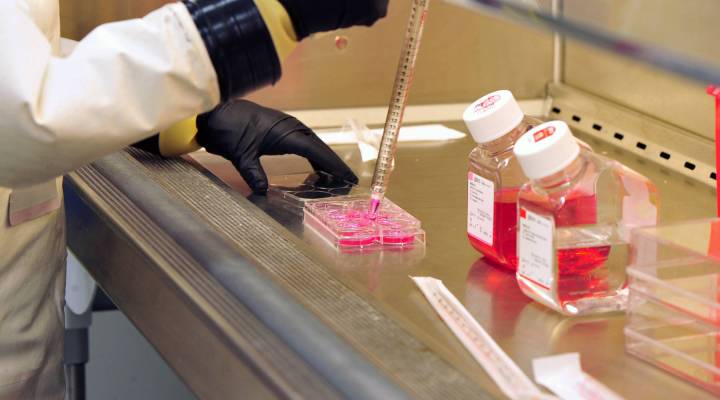
Deadly disease research labs are so busy, they’re turning away work
Deadly disease research labs are so busy, they’re turning away work

Inside what looks like a nondescript office building on the sprawling campus of Texas Biomedical Research Institute is a hub for some of the most cutting-edge disease research in the U.S.
Robert Davey is zipping up a suit his scientists wear when studying deadly pathogens. Davey is the director of the biosafety level 4 lab at Texas Biomedical. He said he never realized a zipper could be water and air tight before starting in this field.
Surrounded by suits hanging on racks, he inflates one like a balloon. “And when you’re getting ready to go in, you would then connect this hose – which is the air line – to the valve,” Davey said over the loud hiss of air.
Just a few feet away through a door that looks like it belongs on a submarine, researchers are developing vaccines and other countermeasures for viruses like Ebola and Marburg.
Outbreaks of serious infectious diseases like Ebola and Avian Flu have tripled since 1980. That has increased demands on the handful of labs in the U.S. that research deadly pathogens. Developing treatments can generate significant revenue for research organizations. Texas Biomedical thinks it can cut down wait times on developing vaccines while generating more revenue for the organization by expanding its privately-funded lab.
Texas Biomedical is an independent, nonprofit research organization. On the 200-acre property, scientists research everything from cardiovascular disease and obesity to AIDS and infectious diseases.
But 40 percent of Texas Biomedical’s revenue comes from this 1,200 square foot lab. And the lab is maxed out.
“Right now it’s 24/7,” said Jean Patterson, a virologist at Texas Biomedical who said the research group is ready for a new and bigger lab.
“At this point in time we are booked solid for two and half years, and we’ve been that way for couple of years now,” Patterson said.
Texas Biomedical Research Institute Virologist Jean Patterson (left) and Institute President Dr. Larry Schlesinger.
The level 4 lab makes $16 million a year in revenue, and because the lab is so busy, in four years the organization has had to turn away $40 million worth of work.
It isn’t clear how many of these level 4 labs are in the United States, because many don’t advertise the work they do. The best estimate is under 10.
“Well it’s absolutely critical,” said Larry Zeitlin, president of Mapp Biopharmaceutical. Mapp currently holds a license for a promising anti-Ebola therapy, and without enough labs, getting the right therapy — or in lab speak the proper antibody candidate — to market becomes impossible.
“We can’t show that a candidate works. We can’t satisfy the FDA that the candidate is appropriate for development,” Zeitlin said.
Zeitlin often partners with the Galveston National Laboratory, also located in Texas. Its level 4 lab is more than 10 times the size of Texas Biomedical’s and research is still booked 12 to 18 months out. Despite securing $121 dollars in contracts last year, Galveston National Laboratory director James LeDuc said any lab should be cautious about expanding.
“Simply because these labs are extremely complex, they’re extremely costly to run and operate. And you need to make sure that there is sufficient demand today and a decade from now to keep them busy,” LeDuc said.
Galveston estimates it spends a million dollars a year just on utilities for its level 4 lab. But Jean Patterson says Texas Biomedical has done the research and its lab expansion makes financial sense.
“And more importantly, we’re not getting the countermeasure out that we need. It’s not just that we aren’t making as much money, it’s that we aren’t able to provide the vaccine and treatments that are necessary to stop these outbreaks” Patterson said.
Texas Biomedical Research Institute is still deciding how big to make its new lab. But Patterson is confident once it’s built, the lab will still be very busy.
| Pharma: an industry shaped by shareholder value |
| Why rare-disease treatments can be big business |
| Drug-resistant infections threaten economy |
There’s a lot happening in the world. Through it all, Marketplace is here for you.
You rely on Marketplace to break down the world’s events and tell you how it affects you in a fact-based, approachable way. We rely on your financial support to keep making that possible.
Your donation today powers the independent journalism that you rely on. For just $5/month, you can help sustain Marketplace so we can keep reporting on the things that matter to you.












